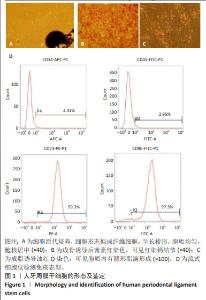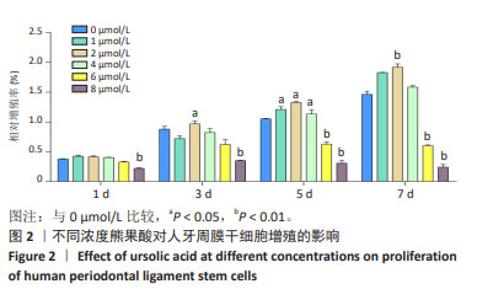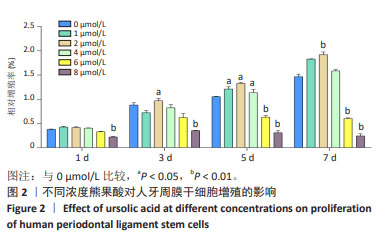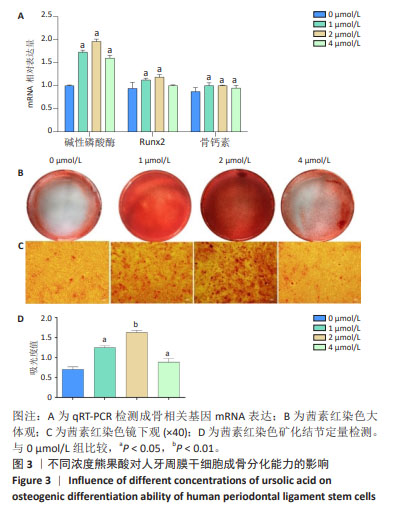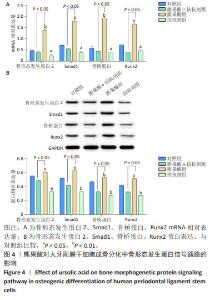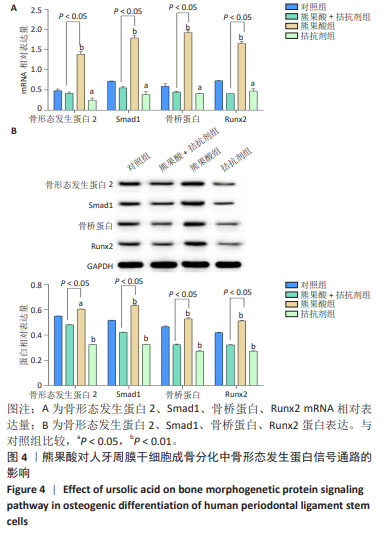[1] 杨孟恺,易诚青.诱导多能干细胞在骨再生中的应用[J].中国医刊, 2017,52(6):20-23.
[2] 王贵玲,仇丽鸿,庞希宁.间充质干细胞的旁分泌作用及其在颅颌面骨再生治疗中的应用研究进展[J].中国实用口腔科杂志,2016,9(6):373-378.
[3] 秦蕴豪,张长青.间充质干细胞促进骨再生的生物学基础及应用[J].中华创伤骨科杂志,2014,16(6):533-536.
[4] ZHOU LL, LIU W, WU YM, et al. Oral Mesenchymal Stem/Progenitor Cells:The Immunomodulatory Masters. Stem Cells Int. 2020;2020:1327405.
[5] JIN SS, HE DQ, WANG Y, et al. Mechanical force modulates periodontal ligament stem cell characteristics during bone remodelling via TRPV4. Cell Prolif. 2020;53(10):e12912.
[6] TRUBIANI O, PIZZICANNELLA J, CAPUTI S, et al. Periodontal Ligament Stem Cells: Current Knowledge and Future Perspectives. Stem Cells Dev. 2019;28(15):995-1003.
[7] LIU J, RUAN J, WEIR MD, et al. Periodontal Bone-Ligament-Cementum Regeneration via Scaffolds and Stem Cells. Cells. 2019;8(6):537.
[8] HAN J, MENICANIN D, GRONTHOS S, et al. Stem cells,tissue engineering and periodontal regeneration. Aust Dent J. 2014;59 Suppl 1:117-130.
[9] MUTHUKURU M. Bone morphogenic protein-2 induces apoptosis and cytotoxicityin periodontal ligam entcells. J Periodontol .2013;84(6):829-838.
[10] WEISS A. The TGF beta super family signaling pathway. Wiley Interdiscip Rev Dev Biol. 2013;2(1):47-63.
[11] MIYAZAWA K, MIYAZONO K. Regulation of TGF-β Family Signaling by Inhibitory Smads. Cold Spring Harb Perspect Biol. 2017;9(3):a022095.
[12] MURAYAMA K, KATO-MURAYAMA M, ITOH Y, et al. Structural basis for inhibitory effects of Smad7 on TGF-β family signaling. J Struct Biol. 2020; 212(3):107661.
[13] LOWERY JW, ROSEN V. The BMP Pathway and Its Inhibitors in the Skeleton. Physiol Rev. 2018;98(4):2431-2452.
[14] JINHUA W. Ursolic acid:Pharmacokinetics process in vitro and in vivo,a mini review. Arch Pharm(Weinheim). 2019;352(3):e1800222.
[15] 赵玉芹,张成杰,相淑芳.熊果酸衍生物对糖尿病骨质疏松骨重塑的影响[J].滨州医学院学报,2019,42(4):291-294.
[16] 方崇锴,杨丽廷,莫宗权,等.基于网络药理学和分子对接探讨熊果酸治疗胃癌的分子机制[J].中国新药杂志,2020,29(20):2372-2380.
[17] POUDEL K, GAUTAM M, MAHARJAN S, et al. Dual stimuli-responsive ursolic acid-embedded nanophytoliposome for targeted antitumor therapy. Int J Pharm. 2020;582:119330.
[18] 朱兆伟,相芬芬,范嫣,等.熊果酸抑制肿瘤生长机制研究进展[J].陕西中医,2020,41(7):999-100.
[19] SPIVAK AY, KHALITOVA RR, NEDOPEKINA DA, et al. Antimicrobial properties of amine-and guanidine-functionalized derivatives of betulinic,ursolic and oleanolic acids:Synthesis and structure/activity evaluation. Steroids. 2020;154:108530.
[20] RAPHAEL TJ, KUTTAN G. Effect of naturally occurring triterpenoids glycyrrhizic acid, ursolic acid,oleanolic acid and nomilin on the immune system. Phytomedicine. 2003;10(6-7):483-489.
[21] CHECKER R, SANDUR SK, SHARMA D, et al. Potent anti-inflammatory activity of ursolic acid,a triterpenoid antioxidant,is mediated through suppression of NF-κB,AP-1 and NF-AT. PLoS One. 2012;7(2):e31318.
[22] KANG H, LEE MJ, PARK SJ, et al. Lipopolysaccharide-Preconditioned Periodontal Ligament Stem Cells Induce M1 Polarization of Macrophages through Extracellular Vesicles. Int J Mol Sci. 2018;19(12): 3843.
[23] 刘耀辉,黄振明,何精选,等.熊果酸干预骨髓间充质干细胞增殖与成骨分化[J].中国组织工程研究,2019,23(17):2665-2671.
[24] SEO BM, MIURA M, GRONTHOS S, et al. Investigation of multipotent postnatal stem cells from human periodontal ligament. Lancet. 2004;364(9429):149-155.
[25] 杨明飞,冉雪琴,王嘉福.BMP-2、Noggin和IGF-1对成骨细胞的调节作用[J]. 广东医学,2010,31(14):1791-1793.
[26] HASHIMI SM. Exogenous noggin binds the BMP⁃2 receptor and induces alkaline phosphatase activity in osteoblasts. J Cell Biochem. 2019;120(8): 13237-13242
[27] 张纯希,李想,周钰翔,等.骨骼微环境中谁决定间充质干细胞的分化命运[J].中国组织工程研究,2021,25(25):4045-4052.
[28] LIU Y, ZHENG Y, DING G, et al. Periodontal ligament stem cell-mediated treatment for periodontitis in miniature swine. Stem Cells. 2008;26(4):1065-1073.
[29] 刘春晖.人牙周膜和人牙髓来源细胞复合多孔HA支架成骨性能研究[D].成都:电子科技大学,2020.
[30] 陈伟健,晋大祥,谢炜星,等.Runx2 基因参与骨代谢相关通路的研究进展[J].中国骨质疏松杂志,2018,24(4):557-560.
[31] 李文雄,张晶宇,杨锋.中药调控骨髓间充质干细胞成骨分化的研究进展[J].中医正骨,2016,28(7):68-71.
[32] 张乃丹,蒋益萍,薛黎明,等.仙茅酚苷类成分促进成骨细胞骨形成和抑制破骨细胞骨吸收[J].第二军医大学学报,2016,37(5):562-568.
[33] 《中国骨质疏松杂志》骨代谢专家组.骨代谢生化指标临床应用专家共识(2023修订版)[J].中国骨质疏松杂志,2023,29(4):469-476.
[34] LI R, ZHU X, ZHANG M, et al. Association of Serum Periostin Level with Classical Bone Turnover Markers and Bone Mineral Density in Shanghai Chinese Postmenopausal Women with Osteoporosis. Int J Gen Med. 2021;14:7639-7646.
[35] 施彦龙,李应福,谢兴文,等.BMP/Smads、 OPG/RANK/RANKL信号通路与骨质疏松关系的研究进展[J].中国骨质疏松杂志,2022,26(4):600-604.
[36] DONG M, JIAO G, LIU H, et al. Biological Silicon Stimulates Collagen Type 1 and Osteocalcin Synthesis in Human Osteoblast-Like Cells Through the BMP-2/Smad/RUNX2 Signaling Pathway. Biol Trace Elem Res. 2016;173(2):306-315.
[37] POON B, KHA T, TRAN S, et al. Bone morphogenetic protein-2 and bone therapy: successes and pitfalls. J Pharm Pharmacol. 2016;68(2):139-147.
[38] GAMER LW, PREGIZER S, GAMER J, et al. The Role of Bmp2 in the Maturation and Maintenance of the Murine Knee Joint. J Bone Miner Res. 2018;33(9): 1708-1717.
[39] 陆跃智,张文杰,蒋欣泉.BMP-2与口腔颌面部骨再生[J].口腔生物医学, 2020,11(4):207-213.
[40] 黄子贤,梁敏.BMP-2对牙周膜干细胞的增殖、分化、迁移的影响[J].牙体牙髓牙周病学杂志,2014,24(9):549-553.
[41] HAKKI SS, BOZKURT SB, TÜRKAY E, et al. Recombinant amelogenin regulates the bioactivity of mouse cementoblasts in vitro. Int J Oral Sci. 2018;10(2):15.
[42] KHANNA-JAIN R, AGATA H, VUORINEN A, et al. Addition of BMP-2 or BMP-6 to dexamethasone,ascorbic acid,and β-glycerophosphate may not enhance osteogenic differentiation of human periodontal ligament cells. Growth Factors. 2010;28(6):437-446. |
